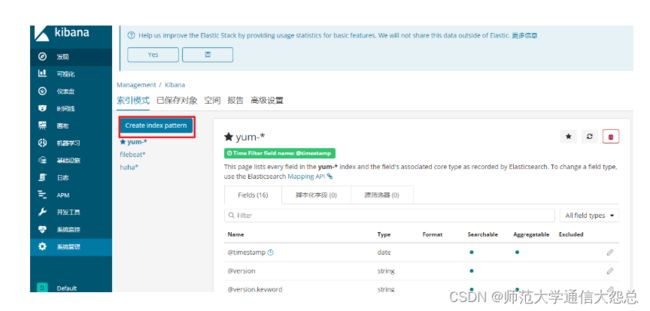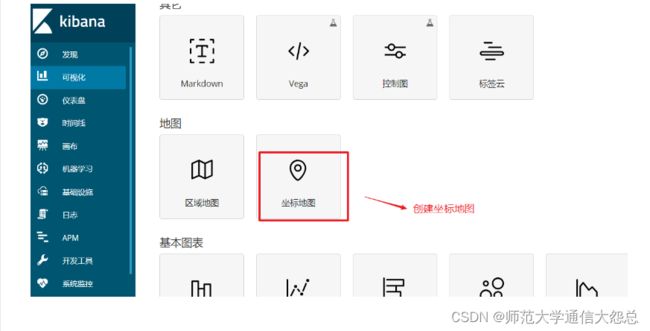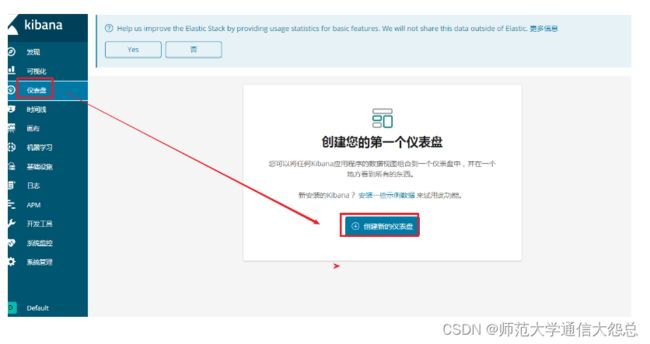ELK综合案例
综合案例
ELK+filebeat+nginx+json
nginx配置
1,在nginx服务器上安装nginx
# yum install epel-release # yum install nginx
2,将nginx日志改成json格式,这样各个字段就方便最终在kibana进行画图统计了
# vim /etc/nginx/nginx.conf
http {
log_format main '$remote_addr - $remote_user [$time_local] "$request" '
'$status $body_bytes_sent "$http_referer" '
'"$http_user_agent" "$http_x_forwarded_for"';
log_format json '{ "@timestamp": "$time_iso8601", '
'"remote_addr": "$remote_addr", '
'"remote_user": "$remote_user", '
'"body_bytes_sent": "$body_bytes_sent", '
'"request_time": "$request_time", '
'"status": "$status", '
'"request_uri": "$request_uri", '
'"request_method": "$request_method", '
'"http_referer": "$http_referer", '
'"http_x_forwarded_for": "$http_x_forwarded_for", '
'"http_user_agent": "$http_user_agent"}';
access_log /var/log/nginx/access.log json; 把main格式换为json格式
# systemctl restart nginx
# systemctl enable nginx
3,使用浏览器或curl或elinks访问nginx.然后查看日志,发现都变成可以转成json格式的格式
# tail -1 /var/log/nginx/access.log
{ "@timestamp": "2019-07-04T17:19:27+08:00", "remote_addr": "10.1.1.1", "remote_user": "-", "body_bytes_sent": "3650", "request_time": "0.000", "status": "404", "request_uri": "/favicon.ico", "request_method": "GET", "http_referer": "-", "http_x_forwarded_for": "-", "http_user_agent": "Mozilla/5.0 (Windows NT 10.0; WOW64) AppleWebKit/537.36 (KHTML, like Gecko) Chrome/55.0.2883.75 Safari/537.36 Maxthon/5.1.5.1000"}
filebeat配置
1,在nginx服务器上安装filebeat安装(filebeat要安装到nginx服务器上收集)
过程省略
2,配置filebeat输出给redis
# cat /etc/filebeat/filebeat.yml | grep -v "#" | grep -v "^$"
filebeat.inputs:
- type: log
enabled: true
paths:
- /var/log/nginx/access.log
filebeat.config.modules:
path: ${path.config}/modules.d/*.yml
reload.enabled: false
output.redis:
hosts: ["10.1.1.14"] IP为redis服务器IP
password: "123456" redis的密码
key: "filebeattoredis"
db: 0
datatype: list
processors:
- add_host_metadata: ~
- add_cloud_metadata: ~
# systemctl restart filebeat
# systemctl enable filebeat
redis配置
1, 在redis服务器上,安装redis并启动(需要epel源)
# yum install redis -y # vim /etc/redis.conf 61 bind 10.1.1.14 需要filebeat可以连接,或者改为0.0.0.0 480 requirepass 123456 # systemctl start redis # systemctl enable redis
# redis-cli -h 10.1.1.14 -a 123456 10.1.1.14:6379> keys * 1) "filebeattoredis" 10.1.1.14:6379> llen filebeattoredis (integer) 6 使用浏览器访问nginx,这里就会有相关信息,6表示有6条日志在队列中
logstash配置
1, 在logstash服务器上安装logstash
过程省略
2, 配置logstash,输入为redis,输出给es
# vim /etc/logstash/conf.d/logstash_from_redis.conf
input {
redis {
host => "10.1.1.14"
port => 6379
password => "123456"
db => "0"
data_type => "list"
key => "filebeattoredis"
}
}
filter {
}
output {
elasticsearch {
hosts => ["http://10.1.1.12:9200","http://10.1.1.11:9200"]
index => "filebeattoredis-%{+YYYY.MM.dd}"
}
stdout {
}
}
# /usr/share/logstash/bin/logstash --path.settings /etc/logstash -f /etc/logstash/conf.d/logstash_from_redis.conf
3, 在redis服务器上查看
# redis-cli -h 10.1.1.14 -a 123456 10.1.1.14:6379> LLEN filebeattoredis (integer) 0 为0了,表示上面6条信息被传到了logstash
# cat /etc/logstash/conf.d/logstash_from_redis.conf
input {
redis {
host => "10.1.1.14"
port => 6379
password => "123456"
db => "0"
data_type => "list"
key => "filebeattoredis"
}
}
filter {
json {
source => "message"
}
}
output {
elasticsearch {
hosts => ["http://10.1.1.12:9200","http://10.1.1.11:9200"]
index => "filebeattoredis-logstashfromredis-%{+YYYY.MM.dd}"
}
stdout {
}
}
注意:这次使用了json插件,索引名请再修改一个新的
如果要画图的话,请重新创建索引模式来匹配新的索引,才能在图形里找到remote_addr这个字段**
# /usr/share/logstash/bin/logstash --path.settings /etc/logstash -f /etc/logstash/conf.d/logstash_from_redis.conf
ELK+filebeat+nginx+grok+geoip
上面的做法还不够高级,下面使用grok插件与geoip插件来实现
1, 停掉前面的logstash进程
-
如果是前台启动,直接ctrl+c即可
-
如果是后台启动, 使用
ps -ef |grep java找出pid,再kill -9 PID
2, 修改nginx日志格式
# vim /etc/nginx/nginx.conf
http {
log_format main '$remote_addr - $remote_user [$time_local] "$request" '
'$status $body_bytes_sent "$http_referer" '
'"$http_user_agent" "$http_x_forwarded_for"';
access_log /var/log/nginx/access.log main; 改为main格式
# systemctl restart nginx
3, 清空日志
# echo > /var/log/nginx/access.log 可以让客户端重新访问几次,确认日志格式正常
4, 配置filebeat并重启
[root@app ~]# cat /etc/filebeat/filebeat.yml filebeat.inputs: - type: log enabled: true paths: - /var/log/nginx/access.log fields: app: www type: nginx fields_under_root: true output.redis: hosts: ["10.1.1.14"] password: "123456" key: "filebeattoredis2" db: 0 datatype: list # systemctl restart filebeat
5, 客户端访问nginx, 查看redis是否有队列
# redis-cli -h 10.1.1.14 -a 123456 10.1.1.14:6379> keys * 1) "filebeattoredis2" 10.1.1.14:6379> llen filebeattoredis2 (integer) 2
6, 使用logstash grok插件完成对nginx日志格式化
# vim /etc/logstash/conf.d/logstash_nginx_format.conf
input {
redis {
host => "10.1.1.14"
port => 6379
password => "123456"
db => "0"
data_type => "list"
key => "filebeattoredis2"
}
}
filter {
if [app] == "www" {
if [type] == "nginx" {
grok {
match => {
"message" => "%{IPV4:remote_addr} - (%{USERNAME:remote_user}|-) \[%{HTTPDATE:time_local}\] \"%{WORD:request_method} %{URIPATHPARAM:request_uri} HTTP/%{NUMBER:http_protocol}\" %{NUMBER:http_status} %{NUMBER:body_bytes_sent} \"%{GREEDYDATA:http_referer}\" \"%{GREEDYDATA:http_user_agent}\" \"(%{IPV4:http_x_forwarded_for}|-)\""
}
overwrite => ["message"]
}
geoip {
source => "remote_addr"
target => "geoip"
database => "/opt/GeoLite2-City.mmdb"
add_field => ["[geoip][coordinates]", "%{[geoip][longitude]}"]
add_field => ["[geoip][coordinates]", "%{[geoip][latitude]}"]
}
date {
locale => "en"
match => ["time_local", "dd/MMM/yyyy:HH:mm:ss Z"]
}
mutate {
convert => ["[geoip][coordinates]", "float"]
}
}
}
}
output {
elasticsearch {
hosts => ["http://10.1.1.12:9200","http://10.1.1.11:9200"]
index => "logstash-nginx-log-format-%{type}-%{+YYYY.MM.dd}"
}
stdout{
}
}
# /usr/share/logstash/bin/logstash --path.settings /etc/logstash -f /etc/logstash/conf.d/logstash_nginx_format.conf
7, 确认redis队列为0,说明传给了logstash
# redis-cli -h 10.1.1.14 -a 123456 10.1.1.14:6379> keys * 1) "filebeattoredis2" 10.1.1.14:6379> llen filebeattoredis2 (integer) 2
8, 模拟假的客户端访问数据(主要是模拟一些假的公网IP)
可手动在nginx服务器上vim /var/log/nginx/access.log复制粘贴多行,然后改成不同的公网IP
9, 在kibana创建索引模式
过程省略











